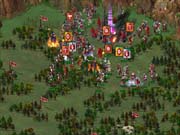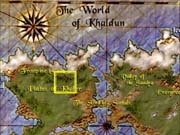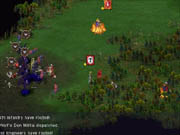Real-time strategy games have evolved in fits and starts since the genre arose with the release of Dune II almost nine years ago. During that time, real-time strategy games have gained notoriety for requiring more mouse-clicking than actual strategy. While games such as Total Annihilation and Age of Empires II streamlined the interface and unit artificial intelligence so as to remove some of the micromanagement, the real-time strategy genre has largely remained fast-paced and thus hasn't appealed to players who prefer a more deliberate approach. The fantasy-themed Kohan: Immortal Sovereigns could very well be the game to bridge this gap.

Kohan does the inconceivable: It introduces real strategy to traditional real-time gaming that doesn't involve any unit micromanagement. While even previous standouts in the genre have relied to some extent on requiring players to get the most out of each individual unit, whether military or civilian, Kohan eliminates this by establishing a completely different level of abstraction. The number of actual units on the map at any given time is quite low, at least at the level of player control. The complexity and strategic depth arise from the construction and manipulation of these units on a larger scale. It's an application of turn-based concepts to real-time gaming that is very much along the lines of Strategy First's more complex game, the recently released Europa Universalis. What Kohan has in common with that game is that it requires you to really think about what you're doing whenever you click a mouse button.
The military model in Kohan is built on the concept of companies. You can raise a limited number of companies based on the number and size of the settlements under your control. The composition of each company can vary widely, and this is the basis for much of the strategy involved in combat. A company has one frontline unit type and up to two support unit types, as well as a captain. The identity of these units depends on their classification and what structures are present in the settlement where the company is being raised. For example, archers and footmen can be either frontline or support units, while paladins and magicians are two types that can take only the support role. In addition, a paladin can be recruited only in a town that has both a barracks and a temple. These unit distinctions and structure dependencies are well integrated into the economic design. There are different factions (ceyah, council, nationalist, and royalist) that have different buildings, upgrades, and units available. Companies can further be grouped into regiments.

Once in combat, a company functions as a unit, although the individual units in that company fight and sustain damage individually. This is where the careful combination of unit types is crucial, since different units grant certain bonuses and have varying attack and defense skills. Once a company is engaged, it will fight until told to retreat or rout (or until it routs on its own). The captain of the company can either be in command mode or engage mode, and when in the latter he fights as a normal unit. Captains can be replaced by heroes (the Kohan immortals of the game's title), and these have additional abilities, such as spells. When a Kohan is killed, he can be "awakened" in a town by paying a price in gold, but only as part of a newly raised company. Otherwise, damaged units heal their hit points while in the "supply range" of a friendly settlement. Awakening a hero is only one of the uses for gold, which is the only resource in the game that is actually used directly.
Unlike almost all real-time strategy games, Kohan has no fixed resources. Instead, settlements produce a variety of resources according to the structures they contain. The key is that while wood, iron, mana, and ore are used to produce gold, none of these resources needs to be mined (except in the rare case of a mine or other reservoir appearing on the map). Instead, resources are generated by structures, and these resources in turn generate gold. A deficiency in one resource can be compensated for by a surplus in another, more valuable resource or by the combination of surpluses in less valuable ones. Constructing a building or other structure almost always causes an increase in the rate of one resource being collected but a deficit in another, so managing these structures is a key element of strategy. Ultimately, the only resource that is actually spent is gold. Gold is collected as a function of other resources present and is generated at the rate of a certain amount per minute. Gold is used to buy buildings and upgrades, awaken heroes, raise and maintain companies, and everything else in the game. One of the skirmish modes even has the amassing of gold as the scenario objective.
None of Kohan's mechanics are especially original in themselves: The company system bears more than a passing resemblance to the army system in the turn-based Warlords series, and the hero focus is reminiscent of Heroes of Might and Magic as well as Warlords Battlecry. The genius of Kohan is that it applies these decidedly abstract design elements to a real-time game without robbing the game of its sense of urgency. While the solo campaign missions do drag at times (which is mostly the fault of the mission design rather than the game system), in skirmish mode or in multiplayer this is not the case at all. Time spent in indecision can be used to effectively punish you, and an enemy offensive is all the more abrupt and jarring if launched after an extended period of seeming inactivity. Being lulled into complacency by the deceivingly slow pace of the game is invariably fatal against good opposition.

Kohan's other achievement is that it doesn't require a human opponent to provide the aforementioned good opposition. Instead, Kohan's computer opponent is perfectly capable of inflicting a stinging defeat on a human player in skirmish mode. While it does receive production advantages on the higher difficulty levels, the computer opponent seems substantially different from traditional real-time strategy AI, and this manifests itself most clearly in the way it eschews mass attacks and reacts selectively to your threats. The computer will ignore an enemy offensive that's not strategically dangerous in favor of massing its forces at a more decisive point and will even accept the loss of peripheral towns to buy time for a well-placed counteroffensive. It even does a good job of using feints to disguise its real targets and makes good use of enveloping tactics. While it's still no match for the best human players, and an experienced player will eventually learn to recognize its patterns, the feeling of playing against Kohan's computer opponent is much different from that of most real-time strategy games. This is especially striking when you first begin play.
Unfortunately, this AI behavior is not so evident in the solo campaign game, which ends up being one of Kohan's weaker points. While the mission difficulty gradually increases, and later missions are both more challenging and somewhat more interesting, the emphasis on storytelling leads to missions that are a bit too tightly scripted. This results in uneven pacing if tasks are performed in the nonprescribed order, and in some cases it can mean the inability to complete a mission since completed objectives are sometimes not credited if not performed in the proper order.
These problems vanish in skirmish mode and in multiplayer, both of which are highly customizable to allow for a wide variety of playing conditions. An excellent feature in the game is the ability to play cooperatively in multiplayer against multiple computer opponents, though all players must have their own copy of the game and their own unique CD key. This caused recurrent difficulties in joining online games, most likely as a result of keys being auto-generated by pirates--which unfortunately means that legitimate users may occasionally be locked out by those who have obtained the game through illegal means.

If Kohan has one real failing, it's the inability to establish a distinctive atmosphere, in the way the Heroes of Might & Magic series did. The sound in the game is a little disappointing, because of the mediocre voice-overs and annoying unit acknowledgements. The graphics are very good, but the game environment is still rather flat. The lack of a distinctive gameworld, despite the good story about the awakening of the Kohan immortals, means the game won't have quite the level of appeal to all players that other strategy classics have. Kohan lifts you out of the nose-in-the-sand environment of micromanagement, but once your head is high enough to take in the surroundings, you realize they're not quite what they could have been. Still, Kohan has its moments in this regard, and the sight of a number of companies encamped (and visibly entrenched), awaiting the start of an offensive, can be an impressive sight.
Kohan's few shortcomings don't diminish the fact that it brings together a variety of proven concepts to offer a real-time strategy experience unlike any other. Players who were turned off by having to click around too much in traditional real-time strategy games and who looked to turn-based gaming instead would be well advised to give Kohan a try. It's a shining example of the fact that you can combine real-time gaming and strategy and come up with something that's an excellent combination of both.